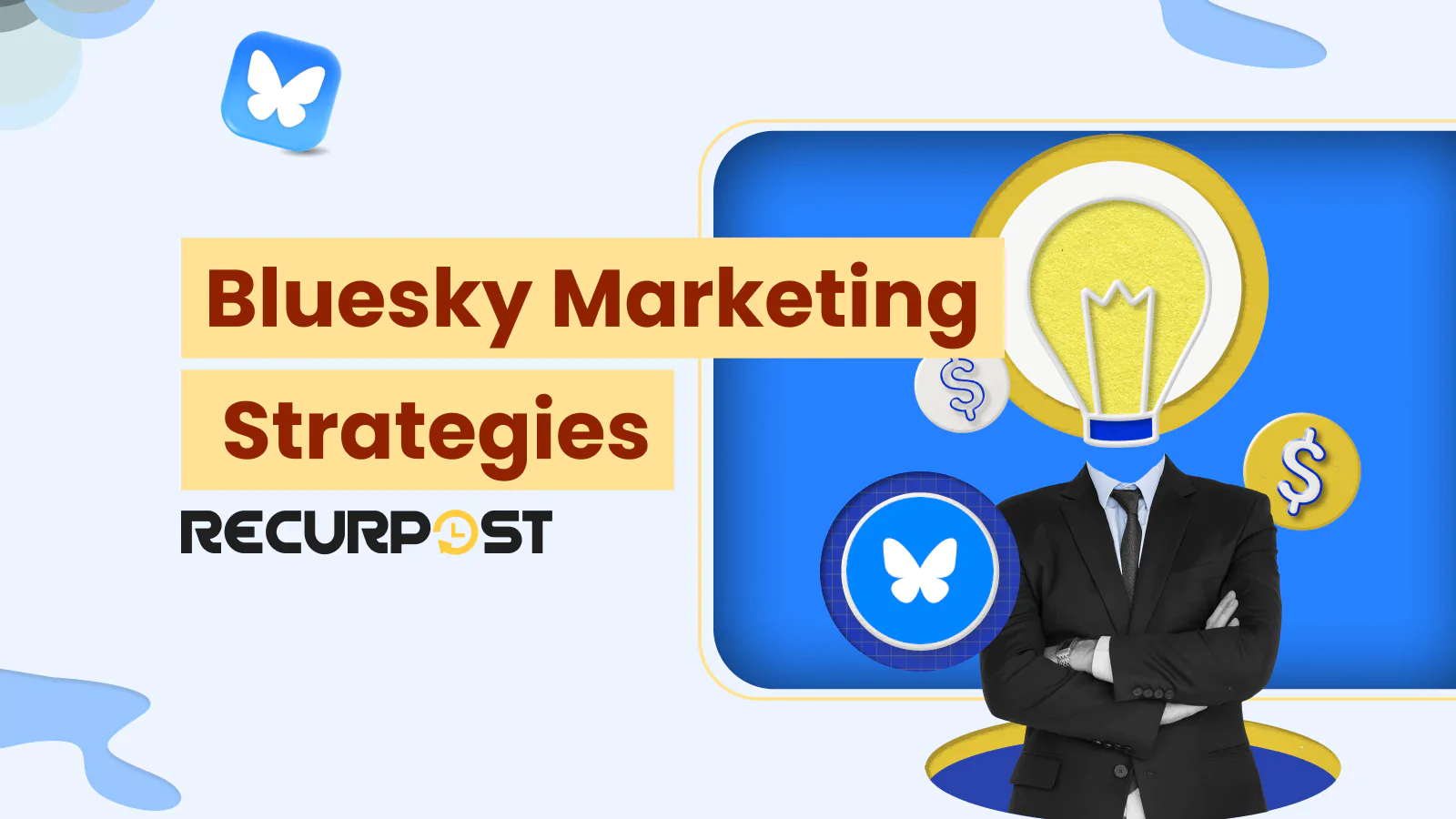Imagine a space where no idea is too wild. That’s the promise of Bluesky marketing strategies: Planning without early limits. This freedom leads to bold campaigns that stand out.
Brands that embrace this approach see real results: a 300% jump in campaign ROI, an 180% boost in brand awareness, and small businesses report a 250% rise in inbound leads
Important distinction: Blue-sky marketing strategies refer to unconstrained creative brainstorming methodologies, while Bluesky (the platform) represents a decentralized social network built on the AT Protocol. This guide covers both the creative methodology and platform-specific tactics for the Bluesky social network.
This guide covers both the creative methodology and platform-specific tactics for the Bluesky social network. You’ll learn how to shape a standout brand promise, turn social media into a playground, and track the numbers that matter. Ready to spark your biggest idea yet?
What Bluesky Marketing Means
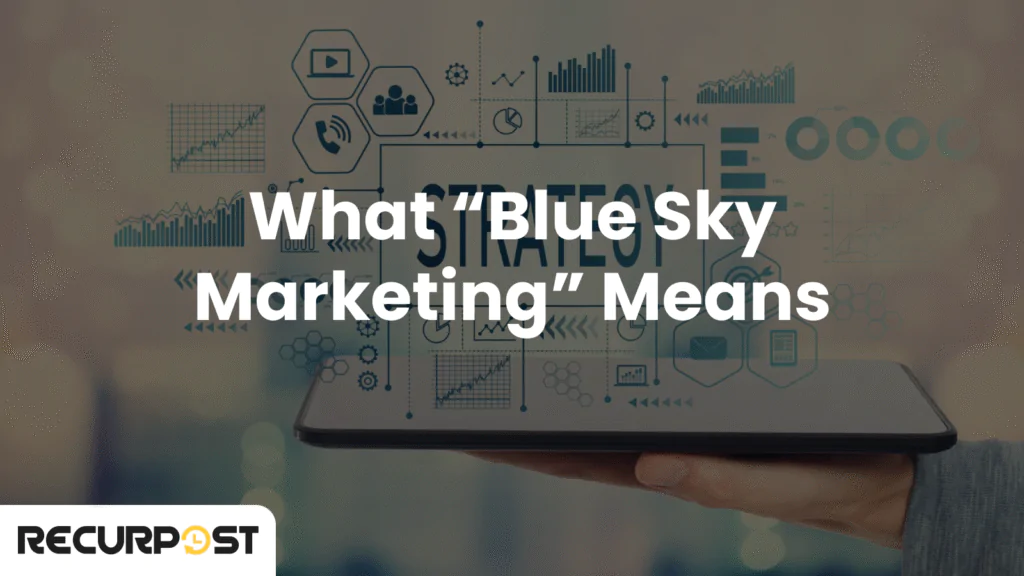
Bluesky marketing asks teams to drop all rules and limits. It invites wild ideas that a normal meeting would never catch. The goal is to spark fresh concepts that stand out in a crowded market.
How It Sparks Breakthrough Ideas
Teams start by jotting down every thought without judging. Blue-sky brainstorming sessions typically generate 40-60 raw ideas within 20-30 minutes. Then they pick two random ideas, like a scavenger hunt and a chatbot demo, and blend them. Idea convergence reduces initial concepts by 70-80% during the selection phase. After that, the strongest ideas get a small test to see which ones truly shine. Pilot tests require 2-4 weeks with budgets ranging from $500-$5,000 for SMBs.
Business Benefits at a Glance
- Companies using Bluesky marketing strategies see a 300% jump in campaign ROI.
- Brands report a 180% lift in how many people know them on social media channels.
- Social posts get 400% more likes, shares, and comments after trying bold ideas.
- Small businesses note a 250% rise in inbound leads when they test new blue-sky ideas.
- Smarter ads cut the cost-per-acquisition by 60%, so dollars stretch further.
Companies that embrace bold, “bluesky” style campaigns often see clear lifts in how many people recognize and recall their brand. We have such real examples with us:
- Airbnb’s “Live There” Campaign
After shifting from traditional tourism messaging to authentic, user‑driven storytelling, Airbnb reported a 14 percent jump in brand awareness following the launch of its global “Live There” campaign, according to Rafael Vilela. (Airbnb Marketing Report, 2017).
- Amazon’s Display & Video Ads
In a Meta‑analysis of Amazon Brand Lift studies, advertisers found that combining display and video formats produced a 2.2× increase in brand awareness compared to baseline metrics, a direct boost driven by creative ad execution and compelling visuals in (Amazon Ads Brand Lift Study, 2023).
These examples show that when companies remove conventional constraints and prioritize creative, audience‑focused storytelling, they can measurably elevate how strongly their brand resonates in the market.
What Readers Will Learn
We’ll cover five core principles, tactics across social media, SEO, email, and more, plus tips for genuine engagement and tracking metrics. Let’s transform your bold ideas into actionable strategies.
Core Principles of Bluesky Marketing Strategies
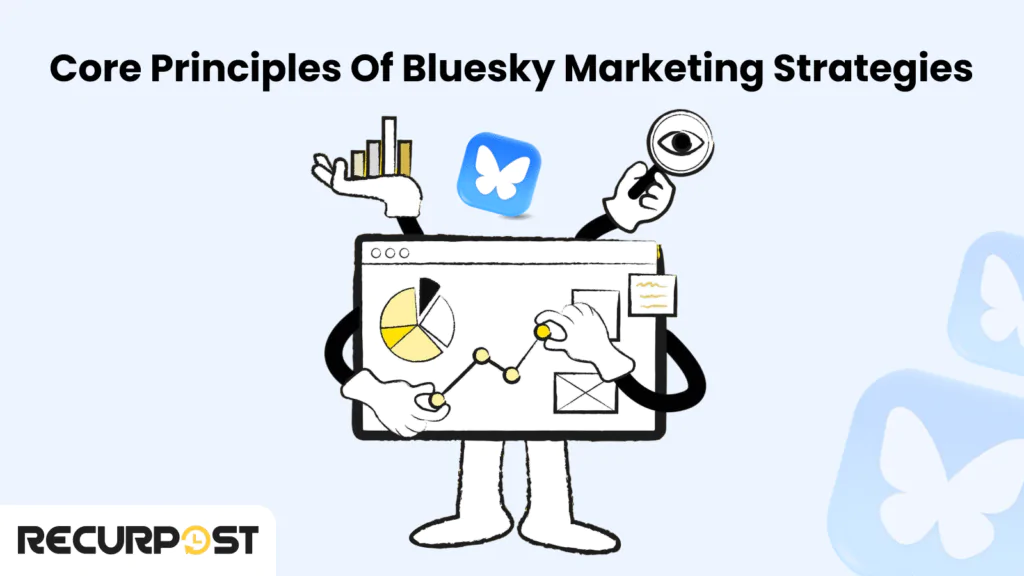
Bluesky marketing creates innovative campaigns that stand out from traditional approaches. Five core principles keep ideas fresh, creative, and results-driven.
1. Creativity First: No Limits, No Boundaries
When brainstorming blue-sky marketing ideas, remove all creative constraints. The goal is to get every thought on the table, no matter how wild it seems. This is how breakthrough ideas are born. Whether it’s creating an engaging social media challenge or turning a product feature into a viral video, you need the freedom to think big.
Real-World Example:
Remember when Old Spice launched its “The Man Your Man Could Smell Like” campaign? That wasn’t your regular deodorant ad. It was quirky, bold, and out-of-the-box, and it led to a 125% sales increase in just a few months (Nielsen Sales Data, 2010; Wieden+Kennedy Case Study).
Tip: Start brainstorming without limits. Allow your team to suggest anything, and don’t dismiss an idea too quickly. Some of the wildest ideas can turn into your most successful campaigns. Allocate 20-30 minutes for unconstrained ideation, targeting 40-60 raw concepts before filtering.
2. Strategic Anchoring: Keep the Big Picture in Focus
Creativity is essential, but every idea needs a clear purpose. Each blue-sky marketing concept must connect to specific business objectives. Every idea must be tied to a business goal, whether it’s increasing leads by 25-50%, growing brand awareness by 30-40%, or engaging your community with 2-5× higher interaction rates.
Real-World Example:
Take Nike’s “Just Do It” campaign. While it was bold and groundbreaking, it was also rooted in a clear strategy: inspire people to take action. That message resonated with millions, and the campaign became iconic. (Source)
Tip: When brainstorming, always start with a clear objective. Ask: “How does this idea help us achieve our main goal?” Whether it’s reaching new customers or increasing conversions by 15-30%, anchoring ideas to a business strategy gives them direction.
3. Data-Informed Refinement: Test, Learn, Optimize
Testing refines big ideas into effective campaigns. Test, refine, and optimize to maximize impact. Data guides the refinement of creative campaigns. Run tests, check key metrics such as engagement (target 2-5% for organic social), reach (aim for 10-20% of follower base weekly), and conversions (benchmark 1-3% for cold traffic), and then adjust. This approach ensures creative concepts resonate with your target audience.
Real-World Example:
When Spotify launched its “Wrapped” campaign, it used customer data to create personalized music summaries for millions of users. The data-driven campaign resulted in over 60 million people sharing their Wrapped stories in 2021, driving incredible engagement and 21% year-over-year user growth (Spotify Wrapped Report, 2021).
Tip: Start with small tests. A/B testing works wonders, whether it’s tweaking your social media post copy (test 2-3 variants), experimenting with ad designs (compare CTR differences of 0.5-2%), or trying out different CTAs (measure conversion lift of 10-40%). Refine based on what the data tells you.
4. Audience Focus: Know Your Audience Like the Back of Your Hand
Bluesky marketing solves real audience problems rather than pursuing subjectively interesting concepts. Design each idea specifically for your target customer. Understanding audience priorities leads to more resonant marketing concepts. Identifying and engaging niche audiences allows for more personalized and effective campaigns by tailoring your content to specific interests or behaviors.
Real-World Example:
Think of Coca-Cola’s “Share a Coke” campaign, where they swapped out their logo for popular names. This campaign worked because it directly connected with people’s desire for personalization. (Source)
Tip: Create buyer personas for your audience. Understand what they love, what they hate, and what they need. Map demographic attributes (age range 25-45, income $50K-$100K), psychographic traits (values sustainability, prefers authenticity), and behavioral patterns (shops online 3-5× monthly, engages with video content). This will help guide every idea and ensure you’re not missing the mark.
5. Integrated View: Bring Everything Together
Effective marketing functions as an integrated ecosystem across channels. Integrated campaigns connect social media, email, content, and more to deliver a consistent message. Coordinating messaging across multiple social media channels ensures a unified brand experience and maximizes reach by 40-60% compared to single-channel approaches. All campaign elements should create a seamless audience experience.
Real-World Example:
When Apple launches a new product, they integrate their campaign across all platforms: TV ads, social media, retail stores, and even their website. It creates a unified experience for their customers, no matter where they encounter the brand.
Tip: Map out your customer’s journey from the moment they hear about your product (awareness stage: 0-7 days) to consideration (7-30 days) to when they purchase it (30-90 days). Make sure every touchpoint reinforces the same message.
These five core principles elevate brand performance through Bluesky Marketing. These principles balance creativity with purpose, testing, and audience focus. Next, we’ll examine the key components that transform blue-sky ideas into actionable campaigns.
Key Strategy Components
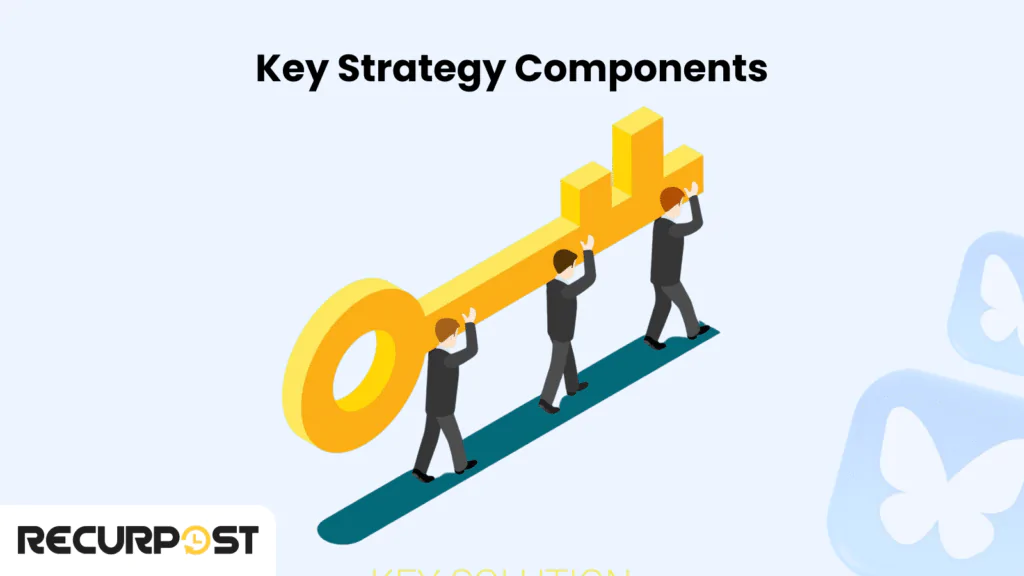
Bluesky marketing transforms bold ideas into successful campaigns through several key components. These elements align creative concepts with business goals and audience needs.
1. Brand Vision & Messaging
Strong brand vision forms the foundation of successful campaigns. This overarching narrative guides all marketing efforts. This vision aligns all ideas with your brand’s mission and values. All messaging and campaigns must remain consistent with the brand’s values to enhance authenticity and credibility.
Implementation Timeframe: Brand vision development typically requires 2–4 weeks.
Tip: Create a one‑line “campaign promise” to guide your ideas. This keeps the message simple and memorable. Example: “We help small businesses automate social media in under 15 minutes daily.”
2. User Generated Content & Storytelling
Compelling storytelling drives campaign effectiveness. Blue-sky marketing experiments with innovative content formats and channels. From videos (60-90 second optimal length) and blogs (1,500-2,500 words for SEO) to interactive content (quizzes, polls generating 2-3× engagement), each piece tells a part of your brand’s story. Content must balance engagement with audience relevance. When planning your post content, focus on crafting posts that encourage conversation and engagement (target 50+ comments per post), rather than simply broadcasting messages.
Implementation Timeframe: Initial content plan and sample pieces take 3–5 weeks.
Tip: Repurpose high-performing content across different channels to maximize its reach. A single blog post can become 5-7 social posts, 1 email newsletter, 3-4 quote graphics, and 1 short video, extending content ROI by 400-600%.
3. Decentralized Social Media Platform & Community Engagement
Social media functions primarily as a community-building space. Interactive challenges, groups, and conversations power blue-sky marketing. These interactions help strengthen the relationship between the brand and its audience, resulting in increased engagement (2-10× higher on community-focused platforms) and loyalty (repeat engagement rates of 40-60%).
Bluesky posts, including images, videos (under 60 seconds perform best), and text (300-character limit), are powerful tools to foster meaningful interactions and boost engagement within your community. To encourage followers to participate, create content that invites them to comment, share their own Bluesky posts, and join threaded discussions (3-5 post threads generate 35% higher engagement).
Active participation, such as responding to comments within 2-4 hours and using direct messages for private conversations, helps build authentic connections. For better recognition and credibility, set up a Bluesky handle that aligns with your brand (domain-based verification like @recurpost.com builds 40% more trust than generic handles).
Implementation Timeframe: Community launch and first engagement round typically take 2–3 weeks.
Tip: Feature user-generated content to build trust and deepen community connections. Brands showcasing UGC see 28% higher engagement rates and 4.5× higher conversion rates
4. Organic Search & SEO
Content value depends on discoverability. SEO drives traffic and increases visibility. Blue-sky marketing uses keyword research to identify untapped opportunities (long-tail keywords with 100-1,000 monthly searches and low competition). Optimizing content with the right keywords (target keyword density of 1-2%, include in H1, first 100 words, and meta description) and incorporating relevant keywords into your content and profile improves discoverability by 50-150% and reinforces your brand identity.
Implementation Timeframe: Keyword research and on‑page updates typically require 3–4 weeks.
Tip: Build a microsite or content hub centered around a unique idea. This helps with SEO (domain authority increases by 15-25 points over 6-12 months) and gives your audience a place to explore your brand. Internal linking between 3-5 related articles boosts page authority by 20-30%.
5. Paid Media with a Twist
Paid ads accelerate campaign scaling. Blue-sky marketing tests innovative ad formats and emerging platforms. Instead of sticking to the usual methods, brands experiment with dynamic ads (personalized creative increases CTR by 2-3×), video (generates 1200% more shares than text and images combined), and emerging platforms (early adopters capture 60-80% lower CPCs) to capture attention.
Implementation Timeframe: Campaign setup and A/B testing can be done in 1–2 weeks, followed by ongoing optimization (weekly adjustments improve ROAS by 20-40% over 90 days).
Tip: Use dynamic creative to tailor messages based on user behavior and data. Segment audiences by demographics (age, location), interests (topic affinity), and behaviors (past purchases, site visits), reducing CPA by 30-50%.
6. Email & Automation
Email drives blue-sky marketing campaigns effectively. Automated email sequences create personalized customer journeys. From welcome emails (average open rate 50-60%) to product recommendations (click rates of 3-5%), automation keeps your audience engaged without extra effort.
Implementation Timeframe: Workflow design and automation setup usually take 2–3 weeks.
Tip: Trigger emails based on user behavior, not just time. Behavioral triggers (cart abandonment, browse abandonment, post-purchase) increase relevance and open rates by 70-100% compared to batch-and-blast campaigns.
7. Experiential & Offline Tactics
Offline tactics complement digital strategies with significant impact. Pop‑up events (generate 30-50 social mentions per attendee), direct mail (response rates of 4.4% vs. 0.12% for email), and guerrilla marketing (viral potential creates 500-1000% earned media value) create buzz and help connect with your audience in unexpected ways.
Implementation Timeframe: Planning and logistics typically require 4–6 weeks.
Tip: Tie offline experiences back to your digital platforms. For example, use a custom hashtag to encourage social media sharing at an event. Events with dedicated hashtags see 3-5× more social amplification and 25-40% longer engagement windows.
8. Metrics & Iteration
Blue-sky marketing balances creativity with measurable results. Clear KPIs track campaign success. These might include ROI (target 3:1 minimum, 5:1 for mature campaigns), traffic (aim for 20-30% month-over-month growth), engagement (benchmark 2-5% rate), or conversion rates (optimize for 2-4% from warm traffic). Adjust strategies based on performance data.
Implementation Timeframe: Dashboard creation and baseline reporting usually take 1 week, followed by weekly reviews (15-30 minute sessions to identify trends and opportunities).
Tip: Use a simple visual dashboard to track trends. Review your campaign’s performance frequently (weekly for active campaigns, bi-weekly for evergreen content) and tweak strategies based on insights. Brands that review metrics weekly improve campaign performance by 25-35% compared to monthly reviews.
These key components form the foundation of bluesky marketing strategies. They transform bold ideas into both creative and effective campaigns. Next, we’ll explore applying these strategies to different audiences.
Tailored Approaches by Audience
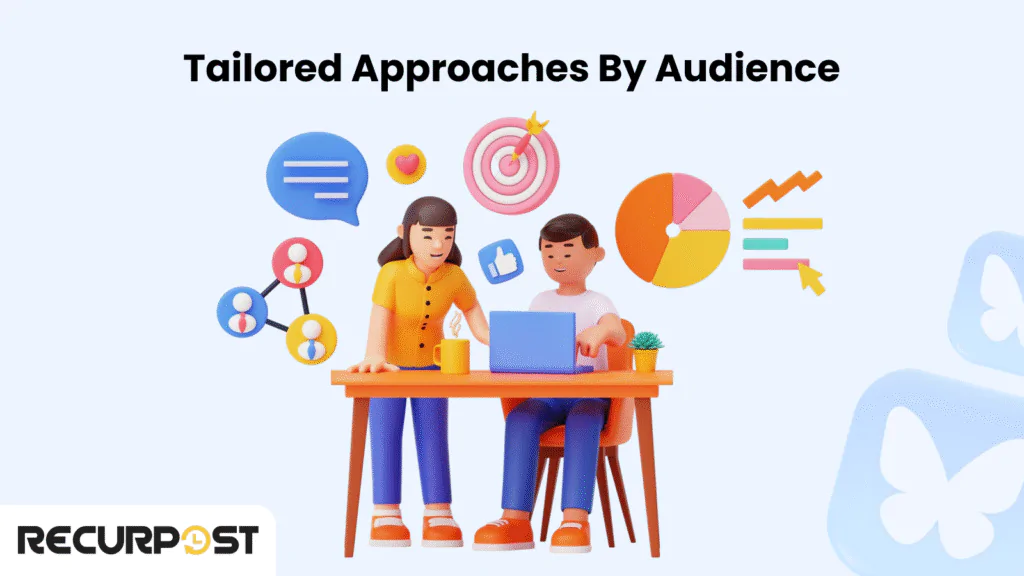
Bluesky marketing requires audience-specific adjustments to maximize effectiveness across different businesses and industries. Here are sector-specific applications:
1. Digital Agencies
Digital agencies leverage Bluesky Marketing to extend their creative capabilities. Emerging technologies and bold experiments help agencies capture client attention.
By closely monitoring and adapting to emerging trends in digital marketing (new platforms reach critical mass at 10-30 million users), agencies ensure they remain relevant and innovative. Positioning themselves as early adopters of new platforms and tools gives digital agencies a competitive edge (first-mover advantage captures 40-60% of early platform ad inventory at 50-70% lower costs) and helps establish influence early in the growth of these channels.
Real Example:
VaynerMedia, led by Gary Vaynerchuk, has been using AR (augmented reality) and AI-driven ads in innovative ways for its clients. This is a great example of how Bluesky strategies help agencies stay ahead of the competition.
Action Steps:
- Run quarterly “blue-sky” workshops where the team brainstorms creative, unconventional strategies.
- Pilot emerging tools like AR or virtual reality (VR) for clients who want to make a bold impact.
- Showcase your innovative wins on your website, turning your agency into a thought leader in creative campaigns.
Tip: Package case studies into bite-sized video reels (30-60 seconds) for social media. Clients love quick, impactful examples of successful campaigns. Video case studies generate 3-4× more engagement than text-based versions.
2. Small & Medium Enterprises (SMEs)
SMEs don’t have the massive budgets of big corporations (average marketing budget 7-12% of revenue vs. 20-30% for Fortune 500), but blue-sky marketing allows them to compete by maximizing creativity. Unexpected approaches and community engagement help SMEs stand out.
Real Example:
Dollar Shave Club disrupted the men’s grooming industry with a single viral video that cost $4,500 to produce. It was quirky, fun, and unexpected, and it turned the company into a household name, generating 12,000 orders in the first 48 hours and leading to a $1 billion acquisition by Unilever in 2016.
Action Steps:
- Launch viral-style social challenges to engage your local community or niche group. Use social media platforms to generate buzz without a massive budget.
- Run rapid tests on small audiences. Test your ideas on a small scale before scaling them up.
- Use local storytelling to highlight the unique elements of your product or service. This can be about your history, your customers, or the community you serve.
Tip: Partner with local micro-influencers (1,000-10,000 followers, engagement rates 5-10%) to build credibility and spread the word in a fun, authentic way. Micro-influencer partnerships cost $100-$500 per post and deliver 60% higher engagement than macro-influencers.
3. Freelancers
Bluesky Marketing helps freelancers develop distinctive personal brands in competitive markets. Creative self-promotion and experimentation showcase freelancers’ unique styles and expertise.
Real Example:
Nathaniel Drew, a freelance content creator, uses YouTube and Instagram to share his journey and expertise uniquely and engagingly. His transparency and creative approach have attracted a huge following (1.5+ million YouTube subscribers), translating to $10,000-$50,000 monthly revenue from sponsorships and digital products.
Action Steps:
- Build your brand around a unique niche. Are you the go-to person for quirky branding, creative writing, or tech solutions?
- Create interactive portfolio demos. Share the process of how you create work, not just the finished product. This gives potential clients insight into your creative process.
- Co-host small virtual events to build your network and offer free insights. This can position you as an expert in your field.
- Use a content calendar to plan, schedule, and manage your content output. This helps maintain consistency, stay organized, and streamline your workflow.
Tip: Offer a free “mini audit” (15-20 minute video or written analysis) for potential clients to showcase your expertise and attract paid work. Free audits convert 20-30% of recipients to paid projects within 60 days.
4. Coaches & Educators
Coaches and educators use Bluesky marketing to create memorable, authentic experiences. This approach builds lasting connections while delivering tangible value beyond service promotion.
Real Example:
Marie Forleo, a business coach, built an online empire by engaging with her audience through inspiring content, free courses (B-School generates $10+ million annually), and a podcast (MarieTV reaches 500,000+ viewers per episode). Her creative, empowering approach to coaching made her a standout in the coaching space.
Action Steps:
- Develop a unique research or a manifesto that showcases your thought leadership and knowledge.
- Use live Q&As or flash workshops as lead magnets to attract new clients.
- Create exclusive online communities where your students or clients can connect and share ideas, creating long-term engagement.
- Showcase customer testimonials, such as video or image testimonials, to reinforce credibility and engagement.
Tip: Use client success videos and customer testimonials to illustrate real impact and build trust with potential clients. Feature specific metrics: “Increased revenue by $50,000 in 6 months” performs 40% better than vague claims like “great results.”
5. Real Estate Agents
Real estate Bluesky Marketing builds community connections through personalized, memorable experiences. Creative strategies help real estate agents differentiate listings and highlight specialized expertise.
Real Example:
Zillow revolutionised real estate listings with interactive features, like home value estimators (Zestimate algorithm analyzes 100+ million homes) and virtual tours (3D walkthroughs increase listing engagement by 40-60%), that set them apart from traditional real estate websites. Zillow’s market cap reached $13 billion by 2021.
Action Steps:
- Create immersive virtual tours or use drone footage for property listings. This gives potential buyers an engaging and detailed experience.
- Focus on hyperlocal guides to showcase the community. Highlight local businesses, parks, schools, and unique features that make the area special.
- Use interactive open houses via live streams to engage potential buyers from afar.
Tip: Send post‑tour survey emails (5-7 questions, 2-minute completion time) to get feedback from your audience, which can improve future campaigns and listings. Survey responses provide insights that increase conversion rates by 15-25%.
Measuring Success
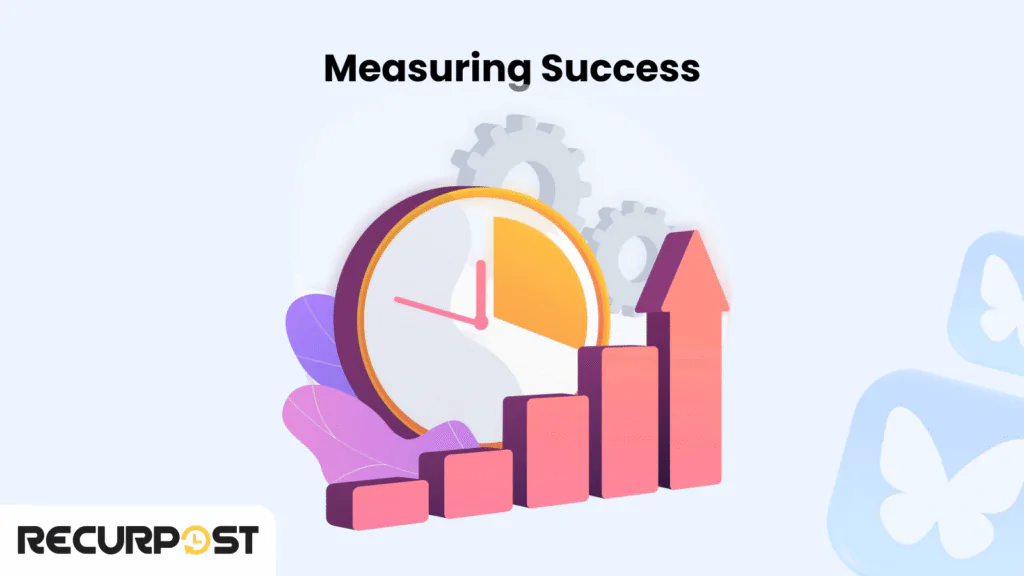
BlueSky marketing strategies deliver measurable results. Campaign success requires tracking appropriate metrics alongside creativity. Measurement identifies effective tactics and enables optimization. Key performance metrics include:
1. ROI & Revenue Growth
ROI provides the definitive measure of campaign success. Despite involving risk and experimentation, blue-sky marketing aims for positive returns. Campaigns that tap into creativity often show impressive returns, whether through direct sales, new customers (customer acquisition cost $50-$200 for B2C, $200-$500 for B2B), or long-term engagement (lifetime value $500-$5,000 depending on industry).
Real Example:
Dollar Shave Club’s viral video ad generated millions in revenue after a small initial investment. They spent $4,500 on production, but their ROI was incredible (12,000 orders worth $120,000+ in 48 hours, 200:1 ROI in the first week), a prime example of blue-sky marketing delivering massive results.
Action Step:
Ask: How much revenue did this campaign generate versus the cost? Track sales (attribute revenue using UTM parameters and promo codes), new customer sign-ups (measure first-purchase conversion rates of 1-3%), or long-term value from the campaign (calculate 12-month LTV of acquired customers). Target minimum 3:1 ROI for experimental campaigns, 5:1 for proven tactics.
2. Lead Volume & Quality
Lead generation drives marketing effectiveness. But it’s not just about how many leads you generate (volume targets: 50-200 monthly for SMBs, 500-2,000 for enterprises), it’s about how qualified those leads are. Blue-sky marketing typically generates purchase-ready, engaged leads (sales-qualified lead rates of 20-40% vs. 5-10% for traditional campaigns).
Real Example:
HubSpot used creative inbound marketing to attract high-quality leads through blogs (500+ articles generating 4.5 million monthly visits), webinars (50-500 attendees per session), and email automation (nurture sequences converting 10-15% to SQLs), which resulted in thousands of sales-qualified leads (SQLs) and contributed to HubSpot’s growth from startup to $1.7 billion in annual revenue by 2022.
Action Step:
Measure lead volume regularly (weekly for active campaigns, monthly for evergreen funnels) and monitor the quality by looking at lead conversion rates (marketing-qualified to sales-qualified: target 30-50%) and how many leads become paying customers (SQL to customer: aim for 20-30% close rate).
3. Engagement (Likes, Shares, Comments)
Engagement metrics indicate campaign resonance with audiences. Audience interactions through likes, shares, and comments demonstrate interest and build brand trust.
Real Example:
Spotify’s Wrapped campaign saw users actively share their year-in-review stats across social media, which resulted in a massive boost in social media engagement. This encouraged organic conversations about the brand.
Action Step:
Track engagement metrics on each platform to see what content resonates best with your audience. Shares and comments are especially valuable because they indicate organic amplification of your content.
4. Website Traffic & Dwell Time
Dwell time indicates content connection beyond simple traffic metrics. Longer dwell times correlate with perceived content value and higher conversion potential.
Benchmarks:
Blog posts: 2-4 minutes average dwell time
Product pages: 1-2 minutes
Landing pages: 45-90 seconds
Bounce rate: Target <50% for content pages, <30% for conversion pages
Real Example:
BuzzFeed’s quizzes regularly drive high website traffic, with users spending more time on the site. This long dwell time keeps them engaged and ready to explore more content or make purchases.
Action Step:
Monitor page views, bounce rates, and time spent on key pages. If you notice people are leaving your site quickly, it may be time to revisit the content to make it more engaging.
5. Cost-Per-Acquisition (CPA)
CPA quantifies customer acquisition costs. Bluesky Marketing aims to reduce CPA while maintaining campaign effectiveness. Lower CPA indicates campaign efficiency and effectiveness.
Industry Benchmarks:
E-commerce: $10-$50 CPA
SaaS: $100-$400 CPA
Professional services: $150-$500 CPA
High-ticket B2B: $500-$2,000 CPA
Real Example:
Airbnb’s “Live There” campaign lowered its CPA by targeting specific, localized audiences with highly relevant ads (geo-targeted creative featuring local neighborhoods), ultimately driving more bookings at a lower cost. The campaign reduced CPA by 30% while increasing booking volume by 14%, demonstrating that creative relevance improves efficiency.
Action Step:
Track CPA across different channels and campaigns to find the most cost-effective strategies:
Social media: $20-$100 CPA
Search ads: $30-$150 CPA
Content marketing: $50-$200 CPA (longer attribution window)
Email marketing: $5-$30 CPA (existing audience)
Focus on lowering CPA without sacrificing the quality of leads or customer engagement (monitor 90-day LTV to ensure low CPA doesn’t mean low-value customers)
Tip: Visualize Trends in a Simple Dashboard for Quick Checks
Data visualization enhances metric tracking. Dashboards enable quick KPI monitoring. Tools like Google Analytics, Tableau, or Google Data Studio track trends and identify optimization opportunities.
Dashboard Setup (15-30 minutes):
1. Connect data sources (Google Analytics, social platforms, CRM)
2. Create 5-7 key metric cards (ROI, leads, engagement, traffic, CPA)
3. Add trend charts (week-over-week, month-over-month comparisons)
4. Set up alerts (notify when metrics drop >20% or spike >50%)
5. Schedule weekly reviews (15-minute team check-ins)
Metric tracking ensures blue-sky marketing campaigns deliver tangible results beyond aesthetic appeal. Clear KPIs enable continuous strategy refinement and success scaling.
Bluesky vs. X (Twitter) Comparison for Marketers
Where should the 2025 budget go?
Bluesky hit ~30M users by Feb 2025. X still serves hundreds of millions across 190 countries. Reach is bigger on X; control and community feel are stronger on Bluesky.
How each platform works
- Bluesky = decentralized (AT Protocol). Data can live on different servers. Followers can move with the account across services. Brands get more control through custom feeds.
- X = centralized. One company owns data, policies, and ads. It’s predictable, with mature tools.
Post formats
- Bluesky: 300 characters, a touch more room than X’s 280. Profiles gained a video tab in Jan 2025 for better discovery.
- Impact: 300 chars ≈ 50–60 words vs. X’s 45–50, which cuts down on awkward abbreviations.
Verification
- Bluesky: Domain-based checks (May 2025). No pay-to-verify. Handles like @brand.com build trust and identity.
- X: X Premium ($8/month) for the check. Easier to access, but perceived by some as less credible.
Ads
- X: Full ads stack—promoted posts, video, follower and website campaigns, granular targeting.
- Bluesky: No paid ads. Growth is 100% organic: content, partners, and community.
Engagement + culture
- Creators often report 2–10x higher engagement on Bluesky despite a smaller audience. People expect real talk and replies, not hard sells.
- X is fine with promos, support threads, and announcements at scale.
Audience + regions
- Bluesky traffic: ~52% US, 8% UK, 6.6% Japan, 5% Brazil, 3% Canada. Early-adopter, privacy-minded crowd; many ex-X users.
- X spans more regions with a broader mix of demographics.
Analytics
- X: Solid native analytics.
- Bluesky: No native dashboard. Use third-party tools (Sprout, Metricool, Vista Social, BlueSkyHunter) or manual tracking.
Discovery
- Bluesky: Custom feeds (e.g., “Quiet Posters,” “Science,” “Catch Up”). Brands can build their own feeds and act as curators.
- X: “For You,” “Following,” hashtags, and trends.
Posting pace
- Pew data shows most news influencers on X post 4+ days/week. On Bluesky, fewer posts but deeper chats. Aim for 1–3 quality posts/day on Bluesky.
Where each fits
- Pick Bluesky for niche communities, higher engagement, domain-based trust, and if the plan doesn’t include ad spend.
- Pick X for massive reach, paid campaigns, native analytics, and established creator networks.
- Use both to diversify risk, cross-promote, and test new communities.
RecurPost angle
Schedule and tailor posts for both platforms in one place. Keep tone culture-fit per network while saving time.
Custom Feeds & Starter Packs
Bluesky’s superpower for discovery and onboarding
Custom feeds and starter packs are Bluesky-only features that turn brands into helpful curators and connectors.
Custom feeds (what + why)
- User-made algorithmic feeds anyone can subscribe to.
- Built around keywords, lists, engagement, time windows, or topics.
- Brands can publish feeds like:
- “Social Media Marketing News”
- “Content Tips”
- “Tool Updates”
- “Marketing Memes”
How they work
A separate feed generator selects posts and returns URIs; the client hydrates the view. Devs can build these with common templates.
Marketing uses
- Own feeds: curate the niche and earn trust.
- Get featured: study popular feeds, match topics and formats, use the right tags, and engage creators.
- Segment audiences: separate feeds for beginners, pros, agencies, and ecom.
- Reward communities: “Customer Wins,” “Community Questions,” “Top Contributors.”
Known examples
“Quiet Posters,” “Science,” “Catch Up,” and “What’s Hot.”
Starter packs (onboarding bundles)
- Named collections of people to follow plus custom feeds to join.
- Quick entry to a topic or community.
- Create from the Starter Packs tab; use “Make one for me” or build from scratch.
Use cases
- Community onboarding: new users, developers, partners.
- Events: conferences, webinars, launches.
- Niche roles: ecom marketers, B2B SaaS founders, agency owners.
- Influencer collabs: co-branded packs that boost reach.
- Customer advocacy: success stories and community leaders.
Measure impact
- Feeds: subscribers, growth, inclusion rate, engagement from feed traffic.
- Packs: opens, follow-through, shares, follower spikes.
Best practices
- Clear feed names, solve a user problem, and promote in bios/pins.
- Keep packs focused (10–30 accounts), update quarterly, write plain-English descriptions, and segment by need.
Competitive edge
LinkedIn, Instagram, Facebook, and X don’t offer this level of user-built discovery and onboarding. This is a real first-mover moat.
Advertising on Bluesky Without Ads
Win attention on an ad-free network
Bluesky bans traditional ads to keep the experience clean and community-driven. That’s a challenge and a gift. Brands rise by being useful, social, and creative.
Why the ban matters
No promoted posts, no paid reach. Growth comes from content, people, and partnerships, not media spend.
The upside
- Level field: smart content beats big budgets.
- More organic reach: fewer interruptions.
- Higher trust: real conversations, not ad pushes.
- Early advantage: build authority now.
1) Influencers on Bluesky
- Find creators with high relevance and engagement (5–15%+ beats raw follower counts).
- Ways to partner: sponsored posts (with clear #ad), product seeding, affiliates, collab threads, and ambassador programs.
- Measure with follower lifts, post engagement, UTM traffic, code redemptions, and post-purchase surveys.
2) Cross-platform lift
- Embed Bluesky posts on blogs and landing pages; invite follows.
- Cross-post with tweaks to match tone on X/LinkedIn/FB.
- Email features: “Best of Bluesky,” follow buttons, and Bluesky-only tips.
3) Organic reach tactics
- Hashtags: 2–3 focused tags beat a wall of noise.
- Timing: weekday AM for B2B; evening/weekend for consumer—then test and track.
- Content that sparks replies: questions, opinions, news takes, behind-the-scenes, UGC, short threads.
4) Build community
- Share data, templates, and step-by-steps.
- Run Q&As, weekly topic threads, live event coverage, and community challenges.
- Feature customer stories and UGC (with credit).
5) Personal brands
- Get leaders and experts posting. People trust people.
- Let functional experts own regular topics (content, analytics, CS, product).
6) Contests and giveaways
- Follow + repost formats, tip-share contests, or “best reply wins.”
- Pick prizes true fans want (not generic gadgets).
- Track new followers, engagement quality, and UGC volume.
7) Partnerships
- Co-marketing bundles, guest takeovers, and joint offers.
- Each partner promotes to their own audience; everyone grows.
Measure success
- Organic: follower growth, engagement trend, mentions/share of voice, custom feed and starter pack inclusions.
- Business: Bluesky traffic, leads, customers, LTV, brand recall.
- Efficiency: time per engagement, CAC vs. paid channels, overall ROI.
Why it’s worth it long-term
Owned audience, compounding reach, higher trust, and lower ongoing costs than paid media.
RecurPost angle
Plan Bluesky content, recycle evergreen hits, time posts well, and keep replies moving, all in one calendar.
Scheduling Bluesky (With Recurpost)
Why schedule?
No native scheduler on Bluesky. Scheduling brings time savings, steady cadence, batch creation, and better timing—especially across multiple networks.
RecurPost for Bluesky
- Fast connect and stable auth.
- Simple editor with date/time pickers.
- Media support (images, video, GIFs) + basic edits.
- Alt text for accessibility.
- Libraries for campaigns and themes.
- Bulk upload via CSV.
- Recurring posts for evergreen items.
- Best time to post suggestions.
- Cross-posting to Bluesky, X, LinkedIn, Facebook, Instagram, Pinterest, GBP, YouTube.
- Team roles and approvals.
- Unified Inbox for replies and mentions.
- iOS/Android apps.
- Curation via Google Alerts + Chrome extension for one-click share.
- Link shortener, pause/resume, ChatGPT captions, and hashtag tips (2–3 smart tags).
Pricing
- Free trial: 14 days, full access, no card.
- Starter: from $25/month for individuals/small teams.
- Scales by profiles, libraries, and users; pricing stays steady—no surprise hikes.
Other tools
- Metricool (scheduling + analytics; free, paid from ~$18/mo).
- Vista Social (AI analytics; from ~$39/mo).
- Buffer (simple UX; added Bluesky in 2025).
- Hootsuite (enterprise; starts ~ $149/mo).
- SocialBee, Planly, CoSchedule also support Bluesky.
Pick the right fit
Check network coverage, analytics needs, budget, team size, content volume, learning curve, and support.
Scheduling best practices
- Sound human. Keep it timely.
- 1–3 strong posts/day on Bluesky.
- Leave room for live replies and news.
- Review weekly to remove stale content.
- Test times; follow RecurPost’s recs, then refine.
- Adapt cross-posts to Bluesky’s conversational tone.
- Track what wins and double down.
- Batch creation to save hours.
Why RecurPost stands out for Bluesky
Stable connections, Bluesky-friendly AI captions, evergreen recycling for new followers, all-in-one workflow, and budget-friendly plans.
Action Plan & Next Steps

Now that you’ve learned the principles, key components, and how to measure success, it’s time to put your Bluesky marketing strategy into action. Here’s a step-by-step action plan to help you launch your campaign, track its success, and make it scalable.
1. Set One Bold Goal
Start by setting a bold, measurable goal. Think of it as your campaign’s North Star. This goal will guide every decision and help you track progress as your Bluesky marketing campaign unfolds.
Example Goal:
“Increase brand mentions by 50% in the next 3 months by using bold social media stunts and customer engagement strategies.”
Tip: Make sure your goal is specific, measurable, and time-bound. Using a clear, numeric target will give you a solid benchmark for success.
2. Schedule Your First Unconstrained Brainstorm Session
The next step is to gather your team and set the stage for creativity. Schedule a brainstorming session where no idea is off-limits. Let the creativity flow, and don’t worry about logistics just yet; this is about getting ideas down.
Action Steps:
- Invite key team members from different departments to offer a variety of perspectives.
- Set a timer for 20–30 minutes and let everyone jot down any idea, no matter how wild it sounds.
- Encourage “crazy ideas” and allow people to build on each other’s thoughts.
Tip: Keep the session fun and judgment-free. Let the ideas flow first and worry about feasibility later.
3. Select Two Pilot Ideas and Assign Owners
After your brainstorming session, it’s time to select two ideas that have the most potential. Choose ideas that are both creative and aligned with your brand goals. Assign clear owners to each pilot idea; this ensures accountability and smooth execution.
Example Pilot Idea:
- A social media challenge to engage your audience (for example, a hashtag campaign or user-generated content contest).
- A viral video series that showcases your brand’s fun side and encourages sharing.
Tip: Choose one “big” idea and one “small but testable” idea. This way, you balance high-risk and low-risk ideas, and both will give you valuable insights.
4. Define Metrics and Tools for Tracking
No campaign is complete without proper tracking. Define the key performance indicators (KPIs) you’ll use to measure success. These could include ROI, engagement, lead volume, website traffic, or conversion rates.
Action Steps:
- Set up a dashboard to monitor your KPIs. Tools like Google Analytics, HubSpot, or Tableau can help visualize performance.
- Choose a tool for social media listening (like Sprout Social or Hootsuite) to track mentions and engagement across platforms.
Tip: Make sure your metrics align with your overall business goals. For example, if your goal is to increase brand awareness, focus on social media mentions and engagement.
5. Review Results Weekly and Scale Winners
Your campaign won’t succeed if you don’t continuously monitor and optimize. Set aside time every week to review performance, analyze the data, and identify which ideas are working and which need adjustments. Be ready to scale the successful ideas and refine the ones that are underperforming.
Action Steps:
- Schedule weekly check-ins to assess progress.
- If a pilot idea is gaining traction, increase investment or expand its reach.
- For ideas that aren’t hitting the mark, tweak the messaging, test a different format, or pause it and test something else.
Tip: Iterate quickly. The faster you adapt, the better your chances are of improving the campaign’s performance over time.
By following this action plan, you’ll set your bluesky marketing ideas in motion and start seeing real results. The key is to keep it flexible and always measure, learn, and optimize. Now, it’s time to take that first bold step!
Conclusion
Bluesky marketing represents both strategy and mindset. This approach breaks conventional boundaries with bold creativity that resonates with target audiences. Unlimited thinking grounded in business objectives helps brands differentiate, engage audiences, and achieve growth.
Successful brands push boundaries rather than playing safe. Risk-taking and experimentation create remarkable brand experiences. Bluesky marketing tactics strengthen brand identity and foster authentic engagement through social media, user-generated content, and custom feeds.
Start your Bluesky marketing journey today. Begin implementing these strategies immediately. Brainstorming wild ideas, running small pilots, or engaging niche communities on Bluesky can shape your brand’s future through creativity and innovation.
Action Step: Grab a pen, jot down your boldest idea, and make the first move toward transforming your content strategy. There are no limits, just possibilities waiting to be unlocked.
Begin by implementing the core principles, setting a bold goal, and following through with consistent tracking and optimization. Implement core principles, set bold goals, and maintain consistent tracking and optimization. Unleash creativity to transform brand presence and drive organic growth through Bluesky Marketing.
FAQs on BlueSky Marketing Strategies
1. How can I grow my Bluesky account and attract more followers?
Growing your Bluesky account starts with consistent engagement and sharing valuable content that resonates with your target audience. To attract followers, focus on authentic content that aligns with your brand’s values. Participate in community discussions and share insights that reflect your brand’s expertise. Using hashtags and leveraging Bluesky’s customizable feeds also helps increase discoverability.
2. What are the advantages of using Bluesky’s decentralized platform over traditional social media?
Bluesky’s decentralized platform offers more control over your content, unlike traditional platforms with centralized algorithms. It allows for greater transparency, user autonomy, and a direct connection with your niche community. This can lead to genuine connections, increased brand presence, and a more loyal following. Additionally, Bluesky provides more flexibility in content creation and moderation tools, ensuring brand safety and authentic engagement.
3. How can I ensure brand safety while using Bluesky for marketing?
To ensure brand safety, make use of the content moderation tools available on Bluesky to monitor user interactions and prevent harmful content. Engage proactively with your audience by participating in community discussions and addressing concerns. Additionally, establish community guidelines for your Bluesky profile to keep conversations respectful and in line with your brand’s values.
4. How can Bluesky marketing help with local customers and targeting specific audiences?
BlueSky marketing strategies are excellent for targeting specific audiences by leveraging customizable feeds and engaging with niche communities. You can create content that speaks directly to local customers, using location-specific hashtags and offering personalized promotions. Bluesky’s decentralized nature allows you to connect with audiences who share your brand’s values and interests, fostering genuine connections and consistent engagement.
5. Can I integrate Bluesky marketing strategies with other platforms for a cohesive campaign?
Yes! One of the strengths of Bluesky marketing strategies is that they can be integrated with other social platforms like Instagram, Twitter, or LinkedIn. By cross-promoting content across multiple platforms, you ensure consistent messaging and brand presence. This helps increase your reach and engagement, as audiences from different platforms will be introduced to your Bluesky content.
6. How do I deal with negative feedback or criticism on Bluesky?
Handling negative feedback on Bluesky requires transparency, empathy, and direct engagement. Address concerns by responding promptly and professionally, showing that you care about the audience’s opinions. Moderation tools can also help to manage inappropriate content and maintain a respectful environment. Turning negative feedback into an opportunity for growth can help build a more loyal and trusting community.
7. How do Bluesky’s custom domains and profile features benefit my marketing efforts?
Bluesky’s custom domain and profile features give you more control over your branding and allow you to create a personalized experience for your followers. With a custom domain, you can drive traffic to a landing page or special promotions, making your marketing plan more targeted. Your Bluesky profile becomes a key part of your brand’s identity, offering a dedicated space for sharing valuable insights and engaging directly with your audience.
8. How does Bluesky’s focus on user control affect content creation?
Bluesky’s focus on user control empowers both brands and users to create and share content without heavy censorship or interference from central authorities. This creates an environment for authentic engagement, where content feels more personal and aligned with users’ values. For brands, this means you can build stronger connections by creating content that directly speaks to your target audience without the interference of a centralized algorithm.
9. How can Bluesky marketing help me build a niche community for my brand?
Bluesky marketing thrives on creating smaller, niche communities that foster deeper engagement. By creating and sharing content that speaks to specific interests, values, or needs, you can attract like-minded individuals who will become passionate advocates for your brand. This approach leads to stronger community connections, consistent engagement, and more targeted growth.

As a passionate content writer, I love blending creativity with research to craft compelling narratives that inform, engage, and inspire. With a strong focus on user engagement and brand communication, I create content that resonates with the audience and drives meaningful interactions.

